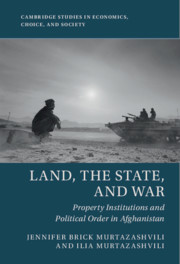Book contents
- Land, the State, and War
- Land, the State, and War
- Copyright page
- Dedication
- Contents
- Photographs and Drawings
- Maps
- Figures
- Tables
- Maps
- Acknowledgments
- Glossary
- Abbreviations
- Chronology of Events
- 1 Introduction
- 2 A Theory of Property Rights
- 3 Property Rights and State Building
- 4 Property Rights and War
- 5 Self-governance of Property Rights
- 6 Self-governance, War, and the Commons
- 7 Self-governance, Legal Titling, and the State
- 8 Are Property Rights a Cause or Consequence of Political Order?
- Appendix
- References
- Index
4 - Property Rights and War
Published online by Cambridge University Press: 20 August 2021
- Land, the State, and War
- Land, the State, and War
- Copyright page
- Dedication
- Contents
- Photographs and Drawings
- Maps
- Figures
- Tables
- Maps
- Acknowledgments
- Glossary
- Abbreviations
- Chronology of Events
- 1 Introduction
- 2 A Theory of Property Rights
- 3 Property Rights and State Building
- 4 Property Rights and War
- 5 Self-governance of Property Rights
- 6 Self-governance, War, and the Commons
- 7 Self-governance, Legal Titling, and the State
- 8 Are Property Rights a Cause or Consequence of Political Order?
- Appendix
- References
- Index
Summary
None of the rulers from the time of Abdur Rahman’s death until the communists seized power in 1978 had his reputation for violence, and the country enjoyed a long peace from the 1930s through the early 1970s. Our theory can explain why despite substantial political order, property rights did not develop much: the rulers who made minor progress in establishing legal property rights had very little state capacity and could not maintain political control, and there was never much progress in establishing political constraints. The communist governments faced even fewer constraints and were largely insulated from local institutions, which contributed to a massively unsuccessful effort to redistribute land, while the Taliban, despite providing some semblance of order and recognizing the importance of customary and traditional institutions, were largely unconstrained and without much administrative capacity to implement any sort of reform. Together, these developments illustrate a key implication of the theory: meaningful progress in establishing property rights requires a monopoly on coercion, high state capacity, strong political constraints on rulers, and inclusive political and legal institutions. Weakness of any of these elements can prevent the emergence of private property rights.
Keywords
- Type
- Chapter
- Information
- Land, the State, and WarProperty Institutions and Political Order in Afghanistan, pp. 65 - 90Publisher: Cambridge University PressPrint publication year: 2021

